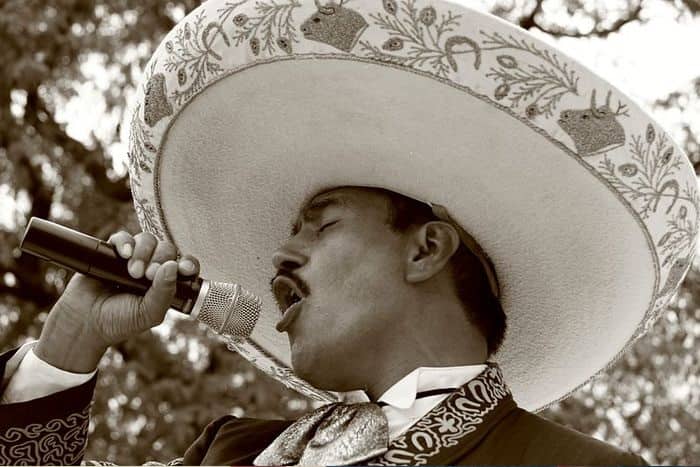Mexican music promises a golden 2020
Mexican music is known throughout the world and many of its songs are chanted and performed in countless places. But this does not prevent the new Mexican musicians from becoming famous.

Mexican music is known throughout the world and many of its songs are chanted and performed in many places. But this does not prevent the new Mexican musicians from also being famous and that some are already preparing for 2020. One example is Carlos Rivera, from Tlaxcala and one of the most outstanding singers of today. His fresh rhythm has brought him fame beyond the borders of the place where he was born.
"There is a mixture of several trends that exist in Mexico," explains the director of the Fonoteca Nacional Mexicana, Pavel Gramados, among which would be those of those performers who emerge from television programs of talent, as is the case of Rivera. Cases such as the Tlaxcalan singer or Alejandro Fernandez a few years ago, which represent Mexican song, are "heirs" of singer Javier Solis, who rose "as the reference of all those who now want to be the national voice" of that country, he added.
In the Mexican music scene, there are many names that will continue to make people talk. Among them, Belinda, who has a long professional career. In addition, this January 31 will debut as a musical actress in the production Hoy no me puedo levantar, playing Maria, the protagonist. "I am in the best position to do my best as an actress, singer, and performer. The important thing is the challenges. Everything comes at the right time and for me, this play came right at that moment," said Belinda in an interview.
It will be a new boost to the career of this singer, who has released four albums and has also participated in soap operas, plays, and television programs. She even collaborated with Juan Magán on the hit song Te voy a esperar.
Beyond Latin Pop
Other performers who have a large number of followers are those who are part of the Sinaloan band or the Mexican regional genre, some of which have many concerts closed for this year. And as an example, the Banda Sinaloense MS of Sergio Lizárraga, better known as Banda MS, whose members will have during 2020 performances in Mexico and in different places in the U.S., such as the famous Coachella festival.
A situation very similar to that of Los Tigres del Norte or La Arrolladora banda El Limón, which will be playing on different stages during the current season. Likewise, the Los Angeles Azules cumbia will be seen in different international venues, especially in Mexico, the USA, and Canada. Despite the fact that this band has been around for no less than 35 years, their songs continue to be a great success with the public. This could be seen during the Grand New Year's Eve celebration held in the centrally located Glorieta de La Palma in Mexico City on the afternoon of December 31st, bringing together thousands of people.
Even classic rock bands in Mexico, such as Café Tacvba or Molotov, confirmed their participation in the XXI edition of the Vive Latino festival, which will take place in the Spanish city of Zaragoza on 11 and 12 September 2020. But unlike the previous genres, Pavel Granados emphasizes the crisis that the ranchera song would be living "right now in Mexico. In fact, the renowned musician and president of the Society of Authors and Composers of Mexico, Armando Manzanero, lamented in 2016 the lack of commitment to the mariachi music industry, according to statements made to local media.
What about the reggaeton in Mexico
A genre that is triumphing worldwide is the reggaeton, which would allow us to hear Latin sounds in a large number of countries. However, "what we consume in Mexico are reggeaton performers from other places, whether it be Colombia or Puerto Rico," Granados added. "The phenomenon of this musical style has done nothing but increase," said the director of the Fonoteca Nacional, although in the country it has not been able to catch on with local artists. "The Mexican reggaeton is still missing," said this specialist, since the majority of the artists heard come from other places.
A situation that would have occurred due to specific circumstances. "I think that in Mexico, and in general, there has been censorship by some people. It is a criticism of class, classism," he added. However, this stigma "is coming to an end", since the style was crowned as one of the most listened-to musical genres in Mexico in 2019, starring the 10 most-watched musical videos on YouTube in the country. "Reggaeton has stopped being a piece of marginal music to become the central genre of, at least, the end of this decade," concluded Granados, since "it has known how to appropriate some things that belong to the pop phenomenon.
A short history of music in Mexico
It is likely that musical instruments already existed in Mesoamerica from the Upper Palaeolithic (40000-10000 B.C.), as bone flutes dating from this period have been found. These are bony whistles with a perforation that were used by hunter-gatherers to imitate the sounds of animals in the hunt. Bone scrapers, tortoise shells, and conch skeletons are also thought to have been used to emit sounds in ritual activities. However, these are only hypotheses that lack verification.

Archaeological excavations have shown that in late Pre-Hispanic times idiophones and aerophones were used for ceremonies, sacrifices, battles, city foundations, births of rulers, seizures of power, funeral processions and rituals, and the images that pre-Columbian peoples have inherited from us prove that there were dance forms and numerous musical instruments widely spread throughout the pre-Hispanic world. This is demonstrated, for example, by the mural paintings of Bonampak, where on one of the walls there are musicians playing trumpets, turtle shells, percussion, or rubbed with deer antlers and drums. Likewise, the texts of the Spaniards speak of songs that were taken from books to be intoned and danced.
With the arrival of the Spaniards in America, religious, profane, and warrior music also arrived from the Iberian Peninsula. Along with them, instruments such as wooden flutes, ivory or wooden cornets, trumpets, shawms, horns, sacabuches, bassoons, guitars, violins, violas, harps, psalteries, and organs entered Mexican territory. In the 16th century, great cultural and artistic centers emerged which, in addition to painting, sculpture, and literature, taught music. In the 17th century, the baroque style prevailed in music and musical forms such as carols, motets, and madrigals. In the 18th century, American music was consolidated, which was increasingly cultivated within civil society and not only in temples. This century saw the emergence of forms of theatrical music such as tonadilla and zarzuela.
Among the main composers of the Colonial Era were the Iberian composers Juan Xuárez, Lázaro del Álamo, Juan de Victoria and Hernando Franco and the Novohispanos Fabián Pérez Ximeno, Francisco de Vidales, Francisco López y Capillas, José Loaysa y Agurto, Antonio de Salazar and Manuel de Sumaya. Hernando Franco (1532-1585), chapel master of the cathedral of Mexico, was one of the most important composers of the virreinal period. His Codex Franco, a manuscript containing a collection of Magnificat, stands out.
In the early years of independent Mexico, associations and organizations were created that promoted concert music education, such as the Philharmonic Society, the Philharmonic Academy, and the Academy of Music. However, in the first half of the 19th century, musicians still had a close bond with the Church; such was the case of José María Aldana, José María Bustamante, and Mariano Elízaga. However, the latter two were also the first to compose some of the first opera works of the 19th century, such as México libre (Bustamante) and La Italiana (Elízaga).
In the second half of the 19th century, musical production in Mexico focused on opera, of great Italian influence. José Antonio Gómez, Cenobio Paniagua, Melesio Morales, Tomás León, and Aniceto Ortega were the most distinguished composers of Mexican music of this period. Ortega was the most relevant of them all, highlighting his piano compositions Invocación a Beethoven and Recuerdo de Amistad, the Guatemotzín opera, and the waltzes Enriqueta and Brillante.
During the Porfiriato, Mexican cultured music sought a national identity, although it received strong influences from late French and German romanticism. At this time, opera was displaced by piano composition, waltzes, orchestral and chamber production, and folklore. The most outstanding composers of Porfiriato were Juventino Rosas, Gustavo E. Campa, Ernesto Elorduy, Felipe Villanueva, Guadalupe Olmedo, and Ricardo Castro.
Source Dca.gob.gt




